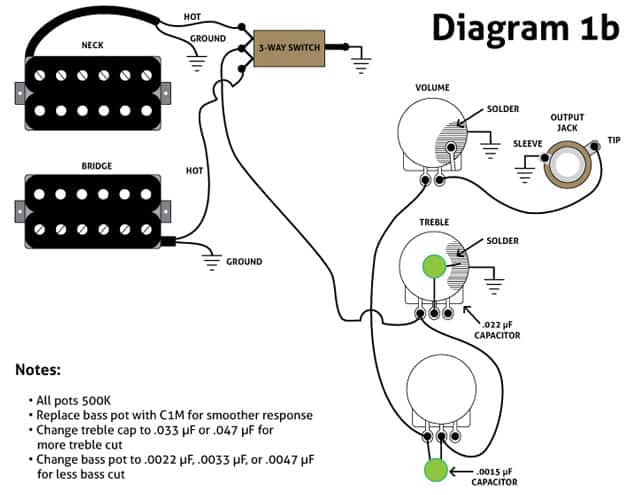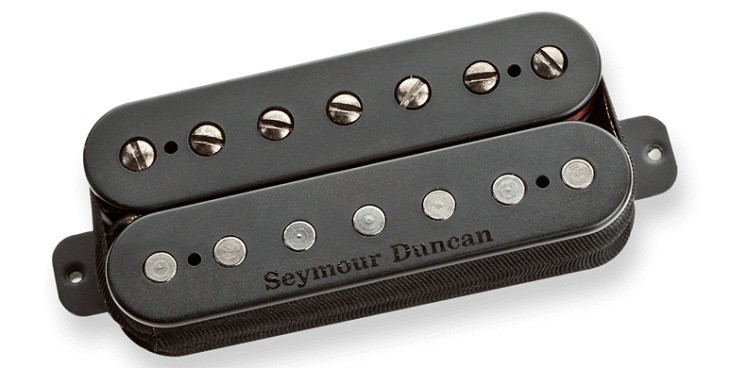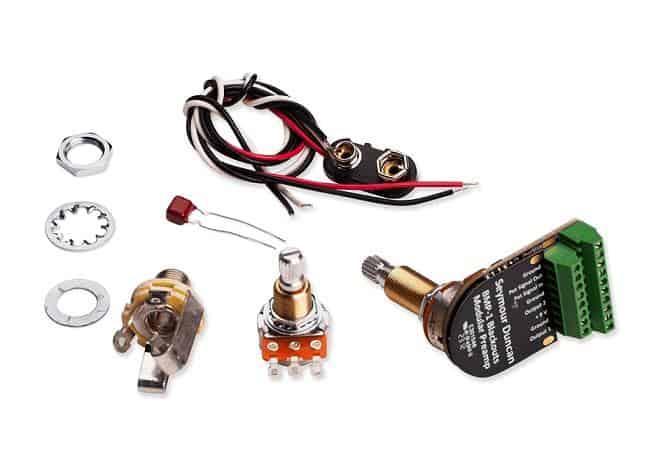So how do guitar pickups work anyway? It’s really surprisingly simple, even for those of us who didn’t do too well in high school science class.
Inside Your Guitar Pickups
At the core of all magnetic pickups is one or more magnets or magnetic pole pieces (as shown in the exploded diagram below), surrounded by a length of hair thin copper wire (42 or 43 gauge) wrapped thousands of times around a bobbin.

What Happens When You Play The Guitar?
When a string is plucked, the vibrations are picked up (hence the name) by the magnet and an electrical signal is generated in the wire. This signal is then transferred though the volume and tone controls and guitar cord or wireless signal to the amplifier, where the weak signal is then boosted to a volume which can be heard over other instruments.
The diagram below shows the most basic signal chain for a two pickup guitar with a three way switch.

The response of the pickup, whether high-pitched, low pitched, noisy and/or quiet, is all based on the magnet and the wire that is wrapped around the bobbin and carries the electromagnetic signal to the amplifier.
2 Main Types Of Magnet
Modern pickups use one of two different types of magnets: Alnico or Ceramic.
Alnico magnets are a compound of aluminum, nickel and cobalt (hence the name), while ceramic magnets are made of ceramic material impregnated with ferrous oxide.
Ceramic magnets: are considered to be “hotter” – i.e. generate a more powerful signal – due to their increased level of magnetism.
Alnico magnets: can be further subdivided into three types: Alnico II, Alnico V and Alnico VIII. Each type has a different ratio of the three elements and therefore produces a slightly different tone:
- Alnico II has a lower output and more mellow vintage tone.
- Alnico V is generally considered brighter with less low end.
- Alnico VII magnets are closer to ceramic and are referred to by some manufacturers as being “high-output”.
This information is important to you, the guitarist, because knowing how your pickup works not only helps you choose the right pickup for the style of music you play, but also comes in handy when you are trying to troubleshoot problems with the electrical system of your guitar.
Additionally, it opens up a plethora of possibilities when it comes to shaping your signature musical tone. Thus, let’s go to next section to choose which ones will fit most with your music style.
Be overwhelmed with choosing the right pickups, this post about 3 main types of pickups (Tone, Design & Comparison) is extremely helpful!
All Wound Up
Single-Coil Pickups
In a single-coil pickup, the wire is wrapped around a single bobbin. This bobbin, usually made of plastic, can come in many shapes and sizes depending on the type of guitar. The number of windings can also vary.
- For a Stratocaster style single coil, the wire can be wrapped around the bobbin as many as 8,350 times.
- For a P-90 style pickup that is even wider, it can have as many as 10,500 windings.

The number of windings is important because it has a very noticeable effect on how a pickup sounds. This is due to something called impedance.
Without getting overly technical, impedance refers to resistance of an electric circuit, in other words, how hard it is for an electrical signal to make it from one end of the wire to the other. The more wire, the wider the frequency response on the low end of the spectrum. Likewise, less wire means a wider response in the high end of the spectrum.
This is why a guitar with single-coil Stratocaster style pickups and no effects pedals will have more treble frequencies and a “twangy” sound. That is why you will see the majority of country music guitarists using Fender Stratocaster or Telecaster guitars.

One of the drawbacks of this method of construction is that any unwanted frequencies that find their way into the signal from any other electrical sources will be carried through to the amplifier, meaning the pickups have a tendency to make undesirable hum.
Double-Coil (Humbucking) Pickups
As a means of eliminating this hum, the double-coil pickup was developed. More popularly referred to as a humbucker – because, obviously, it eliminates the hum – this pickup uses two coils of wire, instead of one, where the poles of the magnets for each coil are reversed. This mean the signals flowing through each coil are moving in opposite directions.

The advantage is that many frequencies cancel each other out, including those that cause hum. Because other signals on both the high and low end also cancel each other out, the pickup’s frequency response tends toward the midrange, meaning that the humbucker has a warmer, fatter sound. This makes humbuckers popular with hard rock and heavy metal guitarists, as well as jazz and blues players.
That’s why the humbucker equipped Gibson line of guitars, like the Les Paul and SG are popular with players in those genres.

Another advantage of humbuckers that is not available to single-coil pickups is the ability to use coil tapping. Humbucking pickups designed to take advantage of this feature can be wired into the controls to allow guitarists to activate only one of the coils instead of both, enabling the guitar to reproduce the sound of a single-coil pickup. Some even allow for the coils to be run in series instead of in parallel.
This means that the signal of one coil is reversed so that the signal in both coils travels in the same direction. This effectively eliminates the humbucking capability or the pickup, but nearly doubles the output. This is known as a “hot” pickup and is favored by guitarists who make heavy use of distortion.
Getting Active
There is another type of humbucking pickup known as an active pickup. Most pickups are passive, meaning that they are unpowered and are capable of only receiving a signal from the vibration of the strings. That signal can only be altered via the controls on the guitar but taking away from the signal. This is the function of a tone control on a guitar equipped with passive pickups. It bleeds off higher frequencies using a capacitor, but cannot actually boost those frequencies.
Are you obsessed with metal? Don’t forget to check out best guitar pickups for metalhead!
An active pickup, on the other hand, is wired into an onboard preamp, i.e., a small amplifier tucked into the guitar’s control cavity. This preamp is powered by a 9-volt battery and allows the artist to boost the higher frequencies when more treble is required, as well as bleed them off when more bass is desired. The preeminent manufacturer of active pickups is EMG and their pickups are especially popular with heavy metal artists such as Metallica.

The Piezo Puzzle
There is one type of pickup that does not fit in with the others in that it does not operate on the principle of electromagnetism. Piezo electricity is an electric charge that accumulates crystals in response to applied mechanical stress, in the case of piezo pickups, that would be the stress applied by the vibration of the strings. The signal generated in the piezo pickup is then passed on to the amplifier in the same manner as it would be in the case of a magnetic pickup. You can check the sound of Piezo Pickups in this demo below:
There is, however, a great deal of difference in how piezo pickups interpret the signal it picks up. Whereas there is a distinct and readily recognizable tone generated by a guitar equipped with magnetic pickups, a piezo equipped guitar has a much more acoustic sound. Many guitarists have equipped their guitar with both magnetic pickups and piezo pickups and blending the sounds to achieve a more unique sound that incorporates the best features of an acoustic and electric guitar.
Wrapping It Up
Hopefully you can see now how understanding how guitar pickups work can greatly increase your chances of finding the guitar tone you are searching for. It’s also useful in maintaining your guitar and diagnosing potential problems.
Not only that, it provides a sound basis for hot-rodding your guitar if that is something you want to look into doing at some point in the future. I hope you enjoyed the article and look forward to the next one. Until then, keep rocking.
Awesome good info!